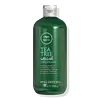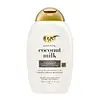What's inside
What's inside
 Key Ingredients
Key Ingredients

No key ingredients
 Benefits
Benefits

 Concerns
Concerns

 Ingredients Side-by-side
Ingredients Side-by-side

Water
Skin ConditioningCetearyl Alcohol
EmollientIsohexadecane
EmollientIsododecane
EmollientBehentrimonium Methosulfate
Melaleuca Alternifolia Leaf Oil
AntioxidantHedychium Coronarium Root Extract
MaskingAscophyllum Nodosum Extract
Skin ConditioningAloe Barbadensis Leaf Extract
EmollientRosmarinus Officinalis Leaf Extract
AntimicrobialAnthemis Nobilis Flower Extract
MaskingSimmondsia Chinensis Leaf Extract
HumectantPPG-5-Ceteth-20
EmulsifyingCitric Acid
BufferingTetrasodium EDTA
Magnesium Nitrate
Bisamino PEG/PPG-41/3 Aminoethyl Pg-Propyl Dimethicone
PEG-12 Dimethicone
Skin ConditioningSodium Glycolate
BufferingMethylisothiazolinone
PreservativeMethylchloroisothiazolinone
PreservativeMagnesium Chloride
Sodium Hydroxide
BufferingParfum
MaskingLimonene
PerfumingCI 42090
Cosmetic ColorantCI 19140
Cosmetic ColorantWater, Cetearyl Alcohol, Isohexadecane, Isododecane, Behentrimonium Methosulfate, Melaleuca Alternifolia Leaf Oil, Hedychium Coronarium Root Extract, Ascophyllum Nodosum Extract, Aloe Barbadensis Leaf Extract, Rosmarinus Officinalis Leaf Extract, Anthemis Nobilis Flower Extract, Simmondsia Chinensis Leaf Extract, PPG-5-Ceteth-20, Citric Acid, Tetrasodium EDTA, Magnesium Nitrate, Bisamino PEG/PPG-41/3 Aminoethyl Pg-Propyl Dimethicone, PEG-12 Dimethicone, Sodium Glycolate, Methylisothiazolinone, Methylchloroisothiazolinone, Magnesium Chloride, Sodium Hydroxide, Parfum, Limonene, CI 42090, CI 19140
Water
Skin ConditioningSodium Methyl Cocoyl Taurate
CleansingDecyl Glucoside
CleansingCocamidopropyl Betaine
CleansingCocos Nucifera Fruit Extract
EmollientHydrolyzed Milk Protein
Skin ConditioningSodium Hydrolyzed Potato Starch Dodecenylsuccinate
Coco-Glucoside
CleansingAmodimethicone
Guar Hydroxypropyltrimonium Chloride
Skin ConditioningHydrogenated Castor Oil
EmollientGlycol Distearate
EmollientPEG-150 Distearate
EmulsifyingHexylene Glycol
EmulsifyingCitric Acid
BufferingSodium Hydroxide
BufferingSodium Benzoate
MaskingParfum
MaskingWater, Sodium Methyl Cocoyl Taurate, Decyl Glucoside, Cocamidopropyl Betaine, Cocos Nucifera Fruit Extract, Hydrolyzed Milk Protein, Sodium Hydrolyzed Potato Starch Dodecenylsuccinate, Coco-Glucoside, Amodimethicone, Guar Hydroxypropyltrimonium Chloride, Hydrogenated Castor Oil, Glycol Distearate, PEG-150 Distearate, Hexylene Glycol, Citric Acid, Sodium Hydroxide, Sodium Benzoate, Parfum
 Reviews
Reviews

Ingredients Explained
These ingredients are found in both products.
Ingredients higher up in an ingredient list are typically present in a larger amount.
Citric Acid is an alpha hydroxy acid (AHA) naturally found in citrus fruits like oranges, lemons, and limes.
Like other AHAs, citric acid can exfoliate skin by breaking down the bonds that hold dead skin cells together. This helps reveal smoother and brighter skin underneath.
However, this exfoliating effect only happens at high concentrations (20%) which can be hard to find in cosmetic products.
Due to this, citric acid is usually included in small amounts as a pH adjuster. This helps keep products slightly more acidic and compatible with skin's natural pH.
In skincare formulas, citric acid can:
While it can provide some skin benefits, research shows lactic acid and glycolic acid are generally more effective and less irritating exfoliants.
Most citric acid used in skincare today is made by fermenting sugars (usually from molasses). This synthetic version is identical to the natural citrus form but easier to stabilize and use in formulations.
Read more about some other popular AHA's here:
Learn more about Citric AcidParfum is a catch-all term for an ingredient or more that is used to give a scent to products.
Also called "fragrance", this ingredient can be a blend of hundreds of chemicals or plant oils. This means every product with "fragrance" or "parfum" in the ingredients list is a different mixture.
For instance, Habanolide is a proprietary trade name for a specific aroma chemical. When used as a fragrance ingredient in cosmetics, most aroma chemicals fall under the broad labeling category of “FRAGRANCE” or “PARFUM” according to EU and US regulations.
The term 'parfum' or 'fragrance' is not regulated in many countries. In many cases, it is up to the brand to define this term.
For instance, many brands choose to label themselves as "fragrance-free" because they are not using synthetic fragrances. However, their products may still contain ingredients such as essential oils that are considered a fragrance by INCI standards.
One example is Calendula flower extract. Calendula is an essential oil that still imparts a scent or 'fragrance'.
Depending on the blend, the ingredients in the mixture can cause allergies and sensitivities on the skin. Some ingredients that are known EU allergens include linalool and citronellol.
Parfum can also be used to mask or cover an unpleasant scent.
The bottom line is: not all fragrances/parfum/ingredients are created equally. If you are worried about fragrances, we recommend taking a closer look at an ingredient. And of course, we always recommend speaking with a professional.
Learn more about ParfumSodium Hydroxide is also known as lye or caustic soda. It is used to adjust the pH of products; many ingredients require a specific pH to be effective.
In small amounts, sodium hydroxide is considered safe to use. However, large amounts may cause chemical burns due to its high alkaline.
Your skin has a natural pH and acid mantle. This acid mantle helps prevent harmful bacteria from breaking through. The acid mantle also helps keep your skin hydrated.
"Alkaline" refers to a high pH level. A low pH level would be considered acidic.
Learn more about Sodium HydroxideWater. It's the most common cosmetic ingredient of all. You'll usually see it at the top of ingredient lists, meaning that it makes up the largest part of the product.
So why is it so popular? Water most often acts as a solvent - this means that it helps dissolve other ingredients into the formulation.
You'll also recognize water as that liquid we all need to stay alive. If you see this, drink a glass of water. Stay hydrated!
Learn more about Water